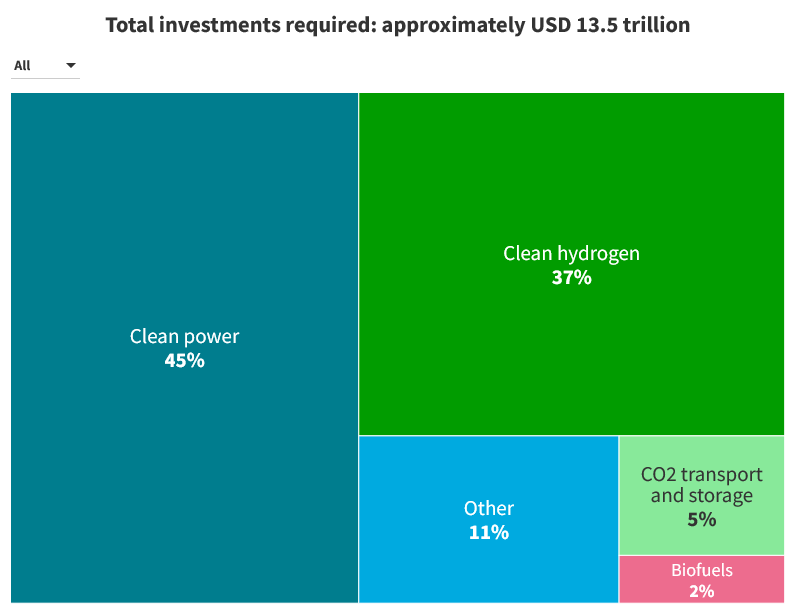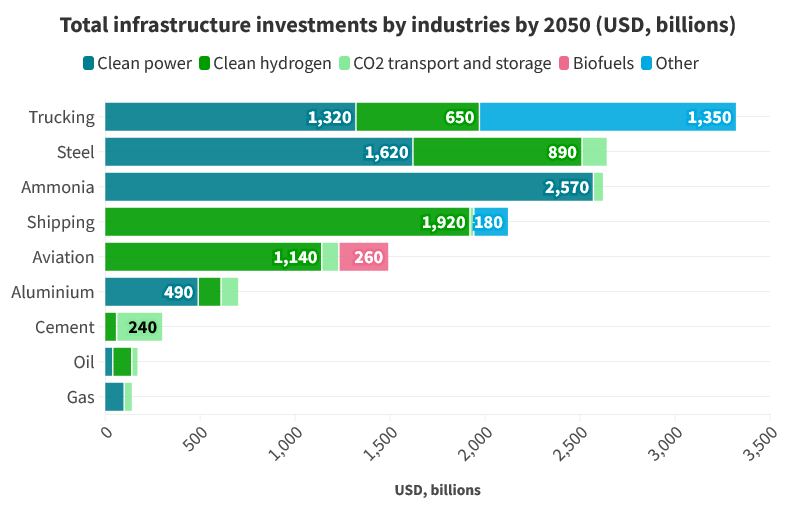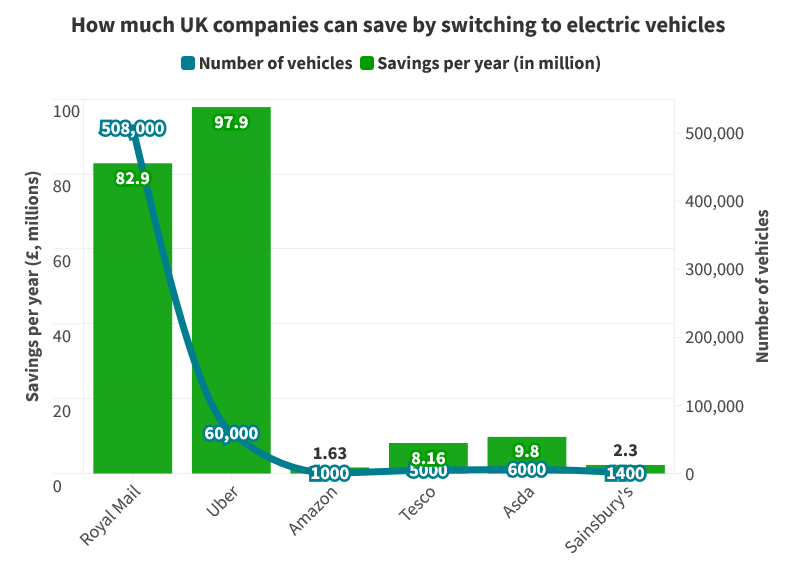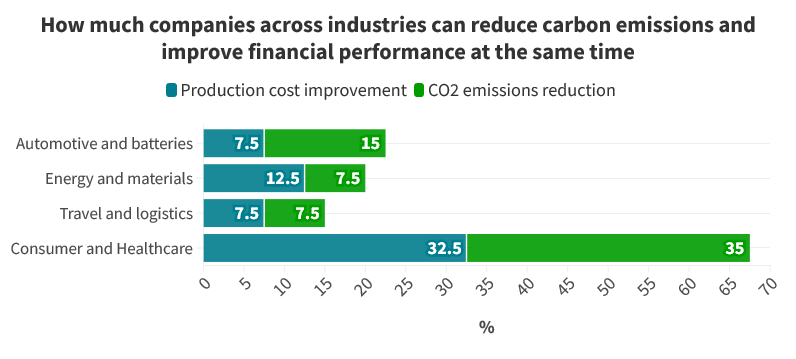Powerful strategies to decarbonize and cut cost

Achieving net zero emissions by 2050 will require businesses to decarbonize and spend approximately USD 275 trillion on physical assets over the next three decades. This amounts to around 7.5% of global GDP annually for the same period.
Decarbonization presents a significant opportunity for the companies, potentially yielding between USD 9 to USD 12 trillion in annual sales by 2030.
On the other hand, companies failing to decarbonize carry substantial financial risks of up to 20% in the same period. These risks include stranded assets, escalating capital costs, and a decline in market share.
Challenges of decarbonization
By 2050, existing climate technologies have the potential to cut approximately 90% of total global emissions. However, it also requires a substantial investment of about USD 13.5 trillion in clean power, clean hydrogen, and carbon capture technologies (Figure 1).
As markets progress and new climate technologies enter the commercial sphere, leaders must maintain flexibility in their decarbonization strategies and capital allocation, prioritizing both cost efficiency and value generation.

However, it also poses a formidable challenge for most companies. Scaling climate technologies and developing new capabilities comes with significant costs. Furthermore, the timelines for decarbonization often clash with performance goals.
On top of that, the added complexities of inflation, energy market disruptions, supply chain shortages, and rising interest rates make it more complicated.
Numerous companies have attempted to decarbonize operations through isolated programs by not fully integrating them into the core business. This can affect both emission reduction potential and financial health.
Decarbonize and make the companies cost effective
Decarbonizing operations often need significant process and capability transformations. It requires strong commitment and accountability from leadership, along with the agility to continuously reassess strategies. Because input costs fluctuate with the emergence of new technologies.

Figure 2 shows total infrastructure investments for certain industries by 2050. Companies can integrate cost and carbon reduction strategies through various means, including enhancing energy efficiency, minimizing waste, and optimizing product design. Nevertheless, companies frequently face challenges in identifying the most effective measures.
There are various ways the companies can assess carbon emissions. For example, how do employees commute to work? Are lights switched off when not in use? How is waste generated and managed? These, among various other factors, collectively influence the carbon footprint of an organization.
Once a company's emissions have been assessed, it is a starting point for analyzing the data. By pinpointing the sources of the highest emissions, the company can develop strategies to address them.
How much money does a company save by reducing emissions?
Even if not legally mandated, assessing carbon footprint helps in identifying strategies to reduce consumption, thereby cutting costs.
Figure 3 shows an example of how much different UK companies with different numbers of vehicles (right) can save in British pounds (left) by switching to electric vehicles (EVs) on average. The data are for Non ULEZ or LEZ Charge Areas. Some key benefits of adopting an EVs fleet include cost savings for the business, for the employees, enhancing sustainability, tax incentives, reduction in maintenance and operational costs, and exemption from Ultra Low Emission Zone (ULEZ) and Low Emission Zone (LEZ) fees.

Related: Cars with wireless charging to transform global EVs market growth
Related: Hybrid vs electric car: how employers can influence the EVs uptake?
Even if industry leaders are committed to decarbonizing and developing net-zero pathways, the absence of reliable customer revenue signals, both in terms of price and volume, hampers execution. This uncertainty presents challenges for businesses seeking to invest in potentially transformative yet uncertain opportunities.
To have effective emission reduction that leads to cost improvement, industries must collaborate across the value chain to establish transparency, clarify infrastructure demand requirements, and prioritize accordingly. Hence, reducing the energy intensity of process activities.
Figure 4 shows the average value of how much the companies can improve in terms of cost by reducing emissions. In the energy and materials sectors, about 7.5% of emissions reduction leads to approximately 12.5% cost cut.

How to decarbonize and launch net-zero successfully?
Successfully launching net zero requires comprehensive strategies to decarbonize, market analysis, and strategy to pinpoint the markets. Especially when leaders aim for ambitious carbon reduction targets or anticipate significant capital investments.
Companies often need to act swiftly in markets plagued by supply shortages, creating new market segments and product categories to maximize carbon reductions. Below are specific actions companies can implement to ensure a successful decarbonization process:
- Start with targeting the initial 20 to 40% of emissions in the decarbonization process. This requires examining all assets and product offerings while providing complete carbon transparency.
- Heavy industry companies, such as metals and chemicals may concentrate on optimizing plant designs and associated capital investments, while manufacturers might prioritize product design to address embedded emissions.
- Direct CEO-to-CEO sales approaches have been effective in recent days, as opposed to traditional procurement channels. Through this, executives can secure initial production commitments and command premium prices.
- Initiate reductions through Scope 1, 2, and 3 emissions. Companies can maximize this potential by focusing on cost reduction and margin improvement within their core operations.
- Forming enduring partnerships with suppliers to mitigate procurement risks and replace high-emission inputs with low-emission alternatives is essential.
Related: The rising interest in tracking Scope 4 emissions
Acting strategically now could determine whether a company gains market share and achieves profitable growth or faces challenges such as stranded assets and higher entry costs in the future. Leaders can promptly implement the most cost-effective measures that contribute to achieving decarbonization objectives.



